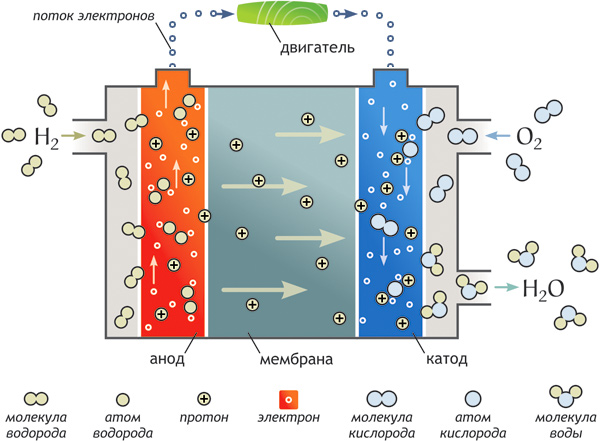Audi's hydrogen-electric hybrid drives 100 km per 1 kg of fuel
Hybrid Audi A7 Sportback h-tron Quattro is capable of driving 500 kilometers on a fuel tank, while water acts as an exhaust. The car uses an electric drive with a hydrogen fuel cell as an energy source in combination with a hybrid battery and an additional electric motor on the rear axle. Acceleration to 100 km / h - 7.9 seconds, top speed - 180 km / h. A full charge of lithium batteries when disconnecting hydrogen fuel cells will allow you to drive another fifty kilometers.

A hybrid car is a car that uses more than one energy source to drive. The main part of modern hybrids is equipped with an internal combustion engine and an electric motor. Audi in this concept decided to move away from the established tradition and use two electric motors, one on the front and rear axles.
The main one uses the electricity generated by the hydrogen fuel cell. The principle of operation of the hydrogen fuel cell is in the image below. The element allows the high-energy reaction H2 + O2 → H2O to be carried out in a quiet mode, without explosion, which accompanies the same reaction in a hydrogen internal combustion engine. The result of the reaction is water and energy. The Audi fuel cell itself contains more than 300 individual cells, the core of each of which is a polymer membrane. The catalyst on both sides of the membrane is based on platinum. The voltage is from 230 to 360 volts.
1 kg of fuel is needed per 100 kilometers, so a full tank will allow you to drive 500 kilometers. Filling with hydrogen takes about three minutes, as is the case with cars with an internal combustion engine.
Energy is stored in a lithium-ion battery. After turning off the fuel cell, it will allow you to drive 50 kilometers at full charge.


Photos from the exhibition in LA 2014.






A hybrid car is a car that uses more than one energy source to drive. The main part of modern hybrids is equipped with an internal combustion engine and an electric motor. Audi in this concept decided to move away from the established tradition and use two electric motors, one on the front and rear axles.
The main one uses the electricity generated by the hydrogen fuel cell. The principle of operation of the hydrogen fuel cell is in the image below. The element allows the high-energy reaction H2 + O2 → H2O to be carried out in a quiet mode, without explosion, which accompanies the same reaction in a hydrogen internal combustion engine. The result of the reaction is water and energy. The Audi fuel cell itself contains more than 300 individual cells, the core of each of which is a polymer membrane. The catalyst on both sides of the membrane is based on platinum. The voltage is from 230 to 360 volts.
1 kg of fuel is needed per 100 kilometers, so a full tank will allow you to drive 500 kilometers. Filling with hydrogen takes about three minutes, as is the case with cars with an internal combustion engine.
Energy is stored in a lithium-ion battery. After turning off the fuel cell, it will allow you to drive 50 kilometers at full charge.


Photos from the exhibition in LA 2014.





